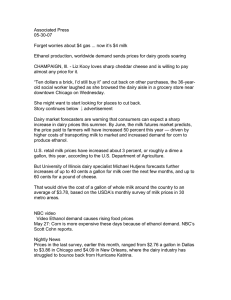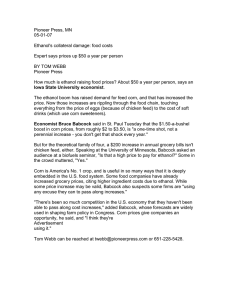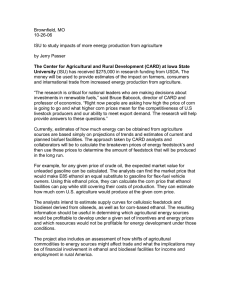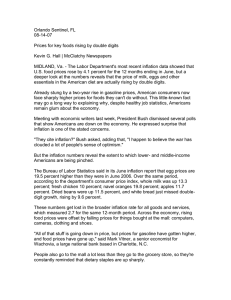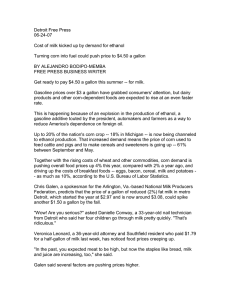Chicago Tribune, United States 06-15-07 Milk chugs toward record high
advertisement
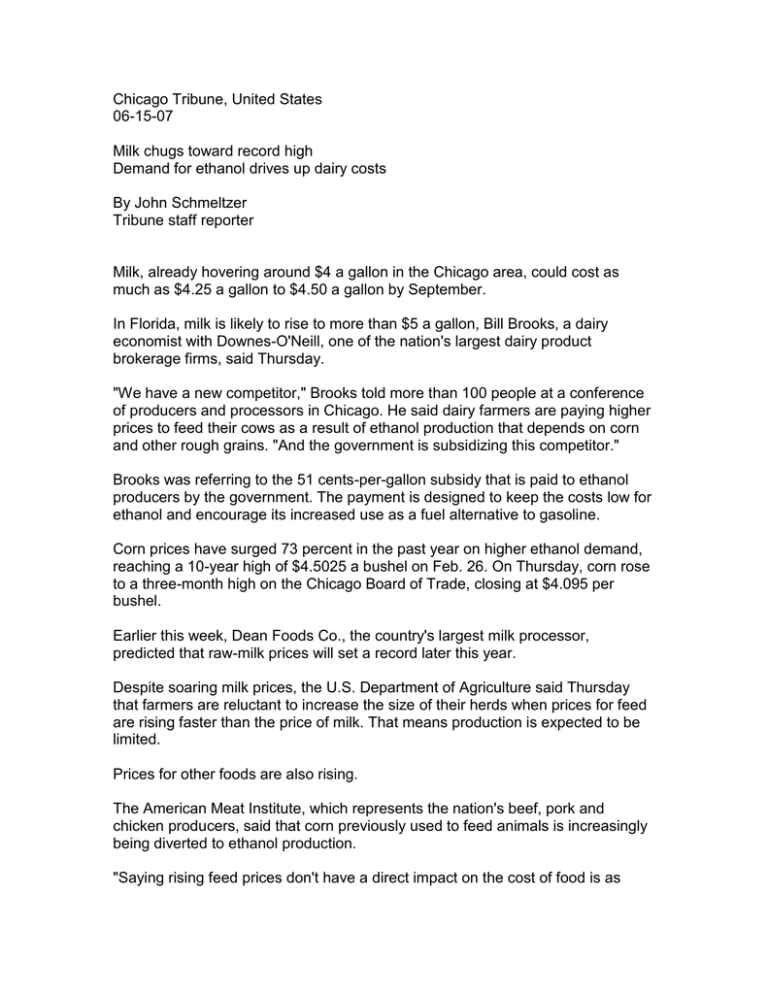
Chicago Tribune, United States 06-15-07 Milk chugs toward record high Demand for ethanol drives up dairy costs By John Schmeltzer Tribune staff reporter Milk, already hovering around $4 a gallon in the Chicago area, could cost as much as $4.25 a gallon to $4.50 a gallon by September. In Florida, milk is likely to rise to more than $5 a gallon, Bill Brooks, a dairy economist with Downes-O'Neill, one of the nation's largest dairy product brokerage firms, said Thursday. "We have a new competitor," Brooks told more than 100 people at a conference of producers and processors in Chicago. He said dairy farmers are paying higher prices to feed their cows as a result of ethanol production that depends on corn and other rough grains. "And the government is subsidizing this competitor." Brooks was referring to the 51 cents-per-gallon subsidy that is paid to ethanol producers by the government. The payment is designed to keep the costs low for ethanol and encourage its increased use as a fuel alternative to gasoline. Corn prices have surged 73 percent in the past year on higher ethanol demand, reaching a 10-year high of $4.5025 a bushel on Feb. 26. On Thursday, corn rose to a three-month high on the Chicago Board of Trade, closing at $4.095 per bushel. Earlier this week, Dean Foods Co., the country's largest milk processor, predicted that raw-milk prices will set a record later this year. Despite soaring milk prices, the U.S. Department of Agriculture said Thursday that farmers are reluctant to increase the size of their herds when prices for feed are rising faster than the price of milk. That means production is expected to be limited. Prices for other foods are also rising. The American Meat Institute, which represents the nation's beef, pork and chicken producers, said that corn previously used to feed animals is increasingly being diverted to ethanol production. "Saying rising feed prices don't have a direct impact on the cost of food is as ridiculous as saying that rising gasoline prices will not result in people paying more to fill up their cars," said David Ray, an institute spokesman. Already, consumers are paying 8 percent to 10 percent more for breakfast foods than a year ago because of the rising prices for corn, wheat, milk and other commodities, according to the Department of Agriculture. Retail prices for orange juice have risen 20 percent to 25 percent from a year ago, while eggs have climbed 15 percent to 20 percent. Overall, food prices are expected to rise 3.5 percent to 4.5 percent, about 1 percentage point higher than in 2006, the USDA estimates. Carl Weinberg, chief economist for High Frequency Economics, has warned that higher food prices could spell trouble for the U.S. economy. "The trend in food prices did not go well in the 1970s, and we fear that a repeat of that squeeze is in progress now," he wrote in a note last week. The USDA estimated this week global grain stockpiles could drop more than 5 percent this year as a result of increased demand and droughts. Weinberg said the new estimate means there might only be a 53-day supply at the end of the year compared to the 69.9-day supply just two years ago. "These stockpiles estimates are as low as they have been since the early 1970s, and that is not good news," he said Thursday. "If food prices jump, then inflation measures will jump." An Iowa State University study of the impact ethanol consumption is having on food prices appears to confirm many of Weinberg's concerns. The study projects that consumers could wind up spending $47 more per person annually on food if oil prices remain above $65 a barrel and grain prices keep rising. Oil closed Thursday at $67.65 a barrel, up $1.39, on the New York Mercantile Exchange. On Thursday, Brian Hoops, an analyst with Midwest Market Solutions in Yankton, S.D., told Bloomberg News that farmers may liquidate hog herds to avoid paying higher feed costs. Hog prices are up 22 percent this year on export demand for pork and higher corn costs. Beef prices are only a little behind; they have risen 16 percent in the past year, reaching a record $1.02925 a pound on March 12. Congress is considering legislation that would require a 36 billion-gallon renewable-fuel standard, nearly four times higher than 7.5 billion-gallon standard required to be met by 2012. Most experts say that the standard will be met mainly with increased production of ethanol and biodiesel fuel. "The problem with government mandates is that they are not responsive to market signals or problems like drought," said Ray from the meat institute. "In terms of food prices, near term, we see the problem getting worse, not better." ---
